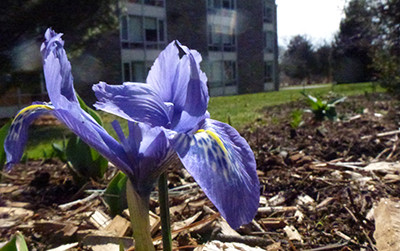
Plants of the Week: March 6
Iris histrioides ‘Lady Beatrix Stanley’
One of the only flowers that seems to have withstood the recent temperature dip and remains resilient is the recently planted Iris histrioides ‘Lady Beatrix Stanley’. This remarkable little flower is a cultivar of the Turkey native Iris histrioides. Though small in stature, its royal blue pops along borders and walkways bringing a pleasant, 3”-5” true-blue accent in the early Spring. The petals appear in flattened, tubular 3’s that sag at the apices to show off white feathering and a bright yellow stripe. The cultivar ‘Lady Beatrix Stanley’ is a dwarf, violet-blue variety. This can be found blooming in small spots in the cut flower garden behind the Wister Greenhouse. photo credit: J. Bickel
Pinus parviflora ‘Adcock’s Dwarf’
The Japanese white pine, Pinus parviflora, as the common name suggests is native to Japan and reportedly grows to heights of 70 feet in its native habitat. Generally speaking, the 3-inch long needles appear in fascicular bundles of 5’s. However the cultivar represented in the Winter Garden next to Martin Greenhouses, ‘Adcock’s Dwarf’, is an exceptionally diminutive dwarf variety. The needles are between 1”-2” and the plant grows very slowly to a maximum width of 3’-4’, nearing 1/10th of the recorded average size of the species parent in its native habitat! This small, needled evergreen has a compact form that makes it a nice choice as a specimen plant in smaller landscape applications. photo credit: J. Bickel

Crataegus viridis ‘Winter King’
Walking along the service drive between the Women’s Resource Center and the train tracks, I noticed an interesting echo across the drive. The grays and oranges of the flaking bark of the leafless Crataegus viridis ‘Winter King’ matched the coloration of the stone in the Cotswold architecture. This added an interesting momentary feeling of completion to that particular section of the service drive that I had never noticed before. The green hawthorne is a United States native, mostly from the south, usually noted for its small clusters of white fragrant flowers and red fruits. The cultivar ‘Winter King’ reportedly has a greater disease resistance than the species and enhanced ornamental features. photo credit: J. Bickel







No Comments